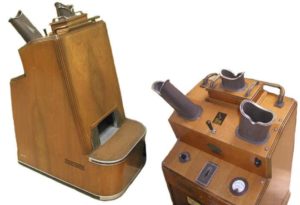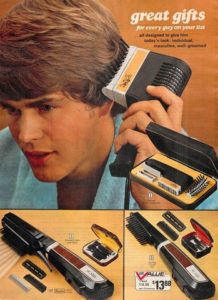
The Wet Head is dead. Long live the Dry Look. Even though I now comb my hair with a washrag, circa 1976, I must have bought a can of The Dry Look at least once a month. It took a lot of hairspray to hold my baby-fine blond hair in place.
It was a relief when I finally gave up trying to make my thin locks look like Roger Daltrey’s massive mane and let my growing expanse of baldness shine. Nowadays, I shave my head twice a week, whether it needs it or not.
But jump back to about 1975, and it was a different story.
Hairstyles for men have changed as much as hairstyles for women. Throughout the 60’s, dudes used Vitalis or Lucky Tiger to keep their locks slicked back and looking good. But when the above commercial first appeared in the early 70’s, sales of hair oil dropped precipitously overnight. A little dab’ll do ya? Forget it. The wet head is dead, complete with his own grave stone to prove the point.
Gillette scored one of its biggest advertising coups ever with this campaign. That’s because word had not yet gotten around to the entire nation that slicked hair was passe’. The 60’s saw long, beautiful hair as a sign of rebellion. But as the turbulent decade faded in the rearview mirror, a less confrontational 70’s saw longer, dryer hair as the new standard for the well-groomed guy’s coiffure. And when you watched the aforementioned commercial, it was clear that the wet stuff had to go ASAP.
Dudes with thick hair required only a light spritz of The Dry Look to keep things under control. How I hated them. My fine hair demanded a veritable deluge of chemical spray to keep that middle part nicely elevated and secured.
Two BIG problems: I rode a motorcycle at the time, and a helmet was required. Ergo, my hair would look like crap when I arrived at my destination. Two, in the mid-south, rain is possible 365 days a year. Not only would the rain destroy my hour of blow-dried art, it created a runoff that tasted like, well, the aforementioned crap.
Of course, the sole purpose of the teenaged male is to attract the amorous attention of the teenaged female. So, to no great surprise, the girlfriends I attracted with my heavily-worked-but-physically-lightweight hair didn’t stick around too long. My lifetime love, 24 years now and counting, was bagged when I gave up and just let my balding head shine in its natural glory.
The wet head may have died in the early 70’s, but the skinhead lives on.















